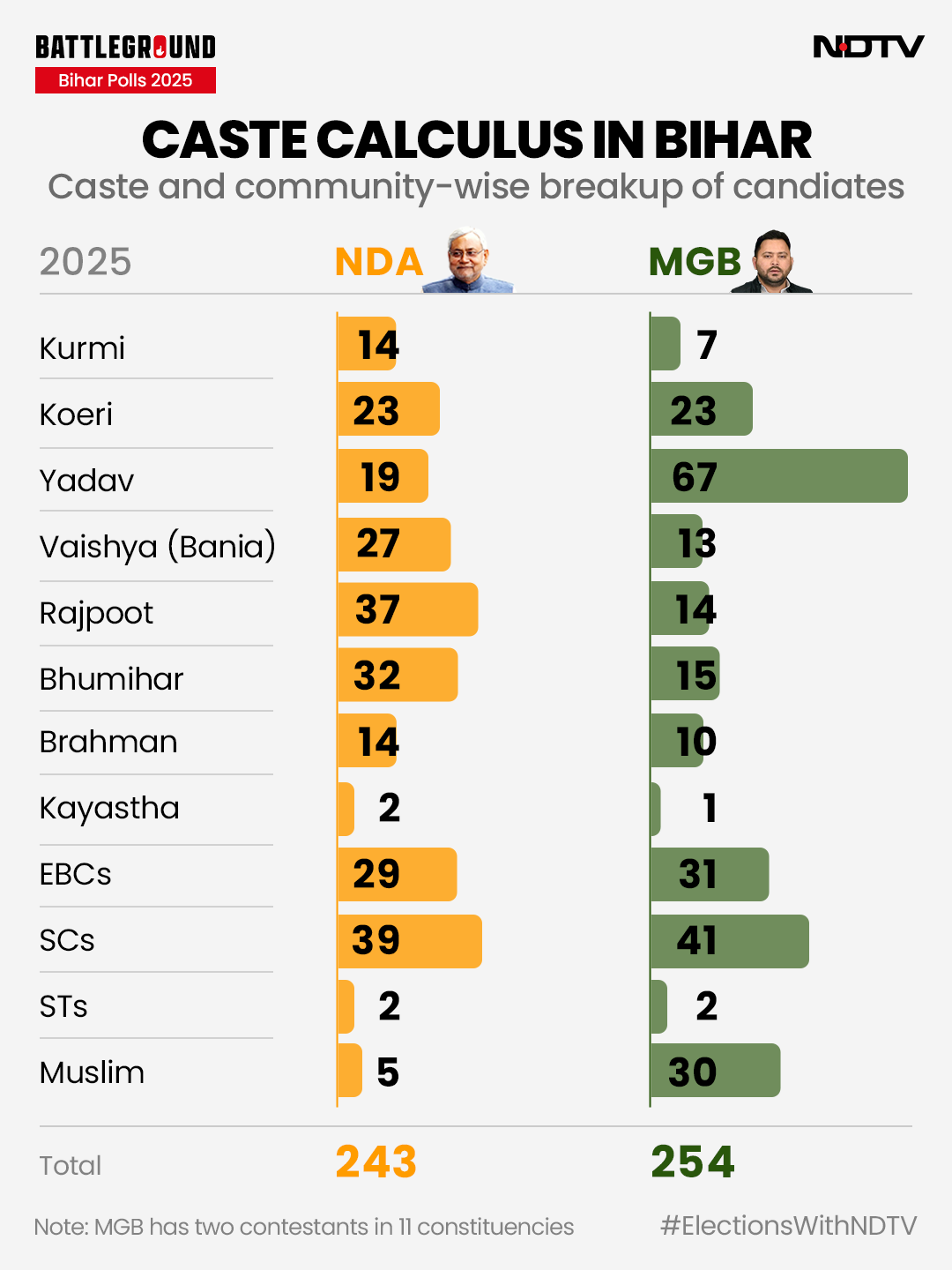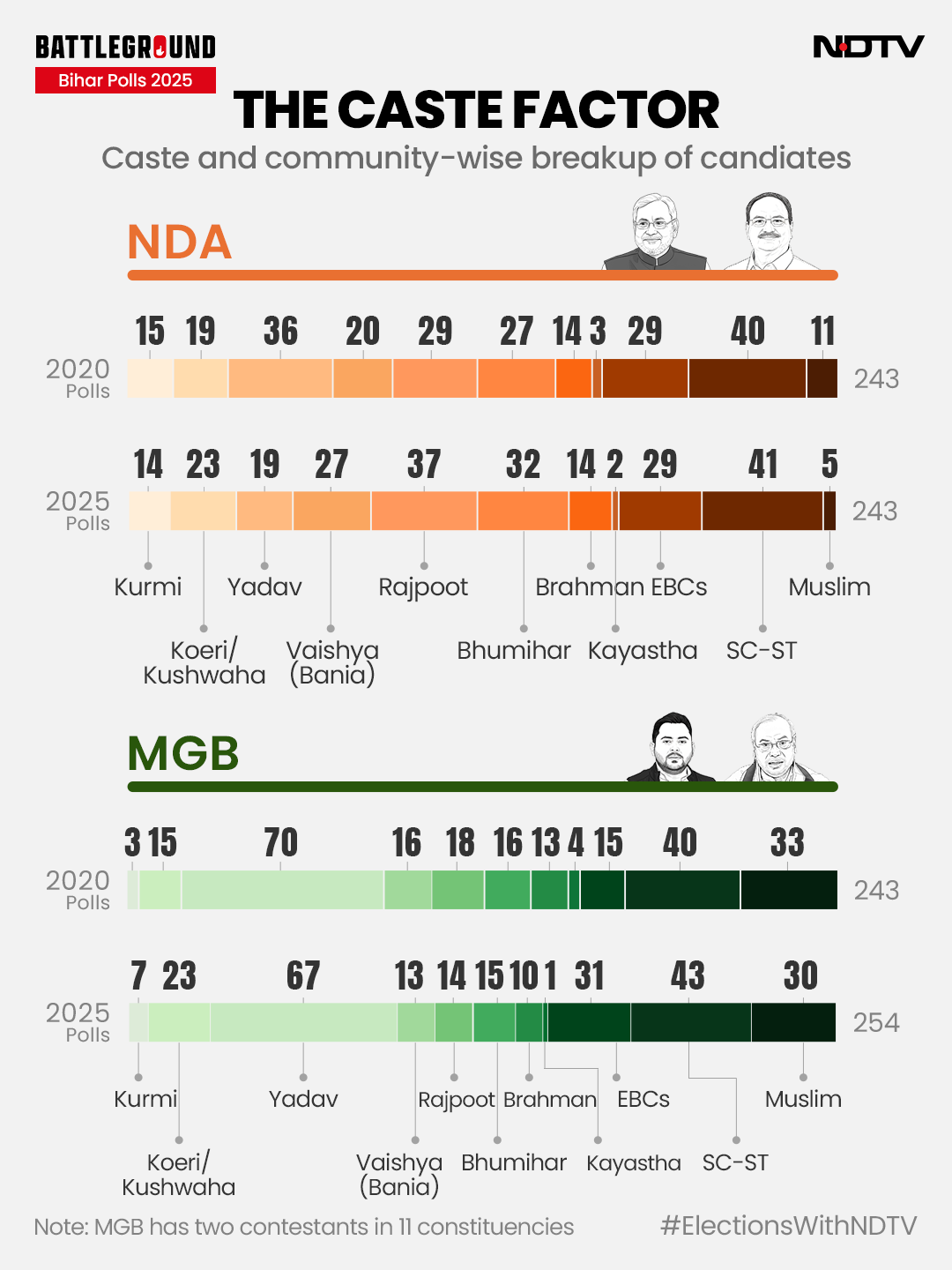
- Bihar's electoral alliances prioritize caste-based vote banks over inclusive slogans in ticket distribution
- Both NDA and Mahagathbandhan underrepresent Muslims despite their 18 per cent population share in Bihar
- Alliances avoid broad coalitions and focus on core supporters to improve winnability in key seats
As Bihar heads into a crucial electoral battle, its major political alliances-the NDA and the Mahagathbandhan (MGB)-have quietly shelved their lofty slogans in favor of hard-nosed caste arithmetic. The ticket distribution reveals a clear retreat to core vote banks, with parties prioritising winnability over inclusive representation.
Slogans vs Strategy
The MGB's progressive slogan "Jiski Jitni Sankhya Bhaari, Uski Utni Hissedaari" (representation proportional to population) and the NDA's inclusive "Sabka Saath, Sabka Vishwas" have been conspicuously absent from the ticket allocation strategy. Instead, both alliances have reverted to their traditional support bases, focusing on consolidation rather than expansion.

NDA: Upper Caste And NYOBC Consolidation
The BJP has leaned heavily on upper caste representation, with Rajputs receiving 21 per cent and Bhumihars 16 per cent of its tickets-far exceeding their estimated 3 per cent population share each. Muslim representation has been reduced to nearly zero, and Yadavs, a core MGB bloc, have been allocated just 6 per cent of BJP tickets.
JD(U), meanwhile, has positioned itself as the champion of non-Yadav OBCs and Extremely Backward Classes (EBCs). With Nitish Kumar hailing from the Kurmi community, the party has reinforced the Luv-Kush bloc by allocating 12 per cent of tickets to Kurmis and 13 per cent to Koeri/Kushwahas. EBCs have received 19 per cent of JD(U) nominations, reflecting a strategic effort to consolidate backward communities wary of Yadav dominance.
Muslim representation across the NDA remains minimal-just 2 per cent of seats-despite Muslims constituting 18 per cent of Bihar's population. The BJP continues its policy of not fielding Muslim candidates in the state.
MGB: M-Y Fortress With Tactical Tweaks
The RJD has doubled down on its Muslim-Yadav (M-Y) base, with Yadavs receiving 37 per cent of its tickets-more than double their 14 per cent population share-and Muslims 13 per cent. Together, half of RJD's candidates hail from the M-Y bloc.
To counter the "Yadav Raj" perception, the RJD has made tactical adjustments: upper caste representation has been reduced to 8 per cent, while Kushwaha and EBC candidates have each received 10 per cent of tickets.
The Congress has attempted to broaden the alliance's appeal by fielding 34 per cent upper caste and 15 per cent NYOBC/EBC candidates, aiming to attract additional vote blocs and balance the MGB's caste portfolio.

SC-ST Outreach And 2020 Lessons
Of the 40 seats reserved for SC-ST communities, NDA has fielded one candidate and MGB three in general category seats to woo these voters. In 2020, voting patterns showed 60 per cent of upper castes, 50 per cent of NYOBC/EBCs and STs backing NDA, while 75 per cent of Muslims and Yadavs supported MGB. SCs were split, with 45 per cent backing NDA.
Winnability Trumps Representation
The data exposes the hollowness of both alliances' slogans. MGB's promise of proportional representation falters as Yadavs receive 26 per cent of alliance seats against their 14 per cent population share, while Muslims remain underrepresented at 12 per cent. NDA's "Sabka Vishwas" slogan rings hollow with Muslim representation at a token 2 per cent.
Both alliances are betting on consolidating their core vote banks-upper castes and NYOBCs for NDA, Muslims and Yadavs for MGB-rather than chasing swing voters or building broader coalitions. This reflects lessons from 2020, when NDA won despite a low vote share of 37 per cent, edging out MGB by just 12,000 votes.

Strategic Shifts Since 2020
The NDA has increased tickets for Rajputs (+8), Bhumihars (+5), Banias (+7), and Kushwahas-aiming to pacify communities that drifted toward MGB in the 2023 general elections. It has reduced tickets for Yadavs (-17) and Muslims (-6).
MGB has responded by increasing tickets for Kurmis (+4), Koeris/Kushwahas (+8), and EBCs (+16), hoping to dent NDA's base. The elevation of Mukesh Sahani as Deputy CM is part of this outreach. Meanwhile, MGB has slightly reduced tickets for Muslims and Yadavs (-3 each) to shed its M-Y-centric image and cut back on upper caste and Bania representation (-16).
No PDA-Style Revolution Yet
Unlike Akhilesh Yadav's PDA (Pichhda, Dalit, Alpsankhyak) coalition in Uttar Pradesh, which helped SP edge out BJP in 2024, Bihar's MGB has not undertaken a transformative social engineering project. While EBC and Kushwaha representation has increased, the changes remain tactical rather than strategic.
Comfort Zones Over Coalitions
As the campaign intensifies, both alliances have chosen to court their core supporters rather than chase swing voters. Symbolic attempts to breach each other's vote banks exist, but the overall strategy reflects a retreat to comfort zones. Whether this proves electorally wise or strategically myopic will be revealed only when the votes are counted. For now, the slogans remain-plastered on posters and echoed at rallies-even as the ticket distribution tells a very different story.
Track Latest News Live on NDTV.com and get news updates from India and around the world

